Following the Family: Creating a Genealogical Index to the St Andrews Burgh Records, c. 1550-1700
A new genealogical resource based on 5 early volumes from the St Andrews Burgh Collection (B65) (held at the University of St Andrews Library under charge and superintendence arrangements on behalf of the Keeper of Records of Scotland) is now available. This includes over 26000 residents of the town, between c 1550 and 1700. You can download the index here: Index to the St Andrews Burgh Records c.1550-1700 (Excel, 1,565 KB)
The project
A wealth of records from the early modern burgh of St Andrews survive and are now held by the University of St Andrews Library’s Special Collections Division. They contain information about the town’s administration, the lives of its inhabitants, their trade, disputes, and crimes. They are a detailed record of everyday urban life in early modern Scotland. Despite their value, few of the St Andrews burgh records have seen much detailed study. Only one, the Convener’s Book of the Seven Trades, has been the subject of an academic article.[1] The poorly legible hand and size of each volume has dissuaded detailed study. Generous funding in 2016-18 from the St Andrews Local History Foundation, 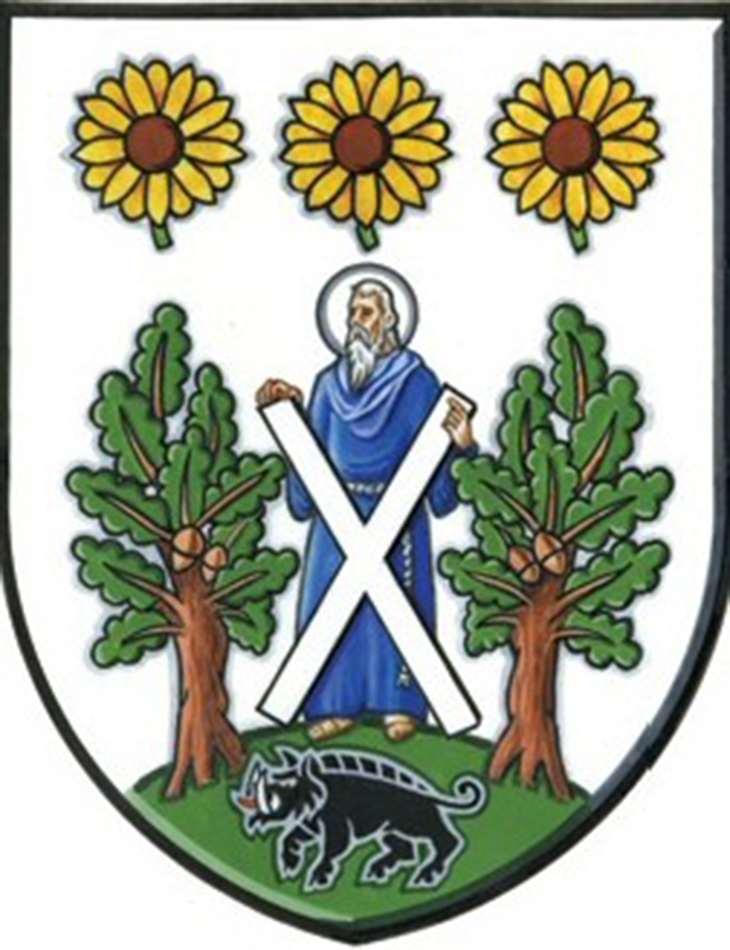 administered by the Burnwynd Trust, has led to the completion of an index of the appearance of each named individual recorded in the burgh records from c. 1550 to 1700. It is hoped that this index will help make these valuable records more accessible to historical and genealogical research. The index stands at over 26,000 entries covering over 1,100 pages across five manuscript volumes.
administered by the Burnwynd Trust, has led to the completion of an index of the appearance of each named individual recorded in the burgh records from c. 1550 to 1700. It is hoped that this index will help make these valuable records more accessible to historical and genealogical research. The index stands at over 26,000 entries covering over 1,100 pages across five manuscript volumes.
The burgh court books record the administration of justice within the town. They number seventeen volumes, three of which fall within the timeframe of this project (B65/8/1 to B65/8/3), though only B65/8/3 features in the index. The minutes of the town’s council also survive and number fifty-two volumes, two dating from between 1550 and 1700 (B65/11/1 and B65/11/2). These documents detail the administration of the town, the elections of its leaders, and the effects of national politics upon St Andrews.
The University also holds records dealing with the burgh’s commercial history, particularly its guilds of craftsmen. The guildry books, of which one volume relates to this project’s chronological scope (B65/16/1), detail the regulation of trade within the town. The Convenor’s Book of the Seven Trades also deals with commerce, containing the minutes of meetings between all seven of St Andrews guilds. The first volume (B65/17/1) relates to this project’s period and records disputes between the guilds and the welfare offered to members.
These volumes represent four key aspects of early modern St Andrews: how it was governed, how peace was kept, how its people lived and how they prospered. Despite the value of these records in furthering understanding of the sixteenth and seventeenth-century town, and wider Scottish society of the period, these documents remain unpublished and under-studied. It is hoped that this index of the people appearing in these records will greatly improve their accessibility, opening up a valuable resource for researchers and genealogists.
The manuscripts
Council minutes
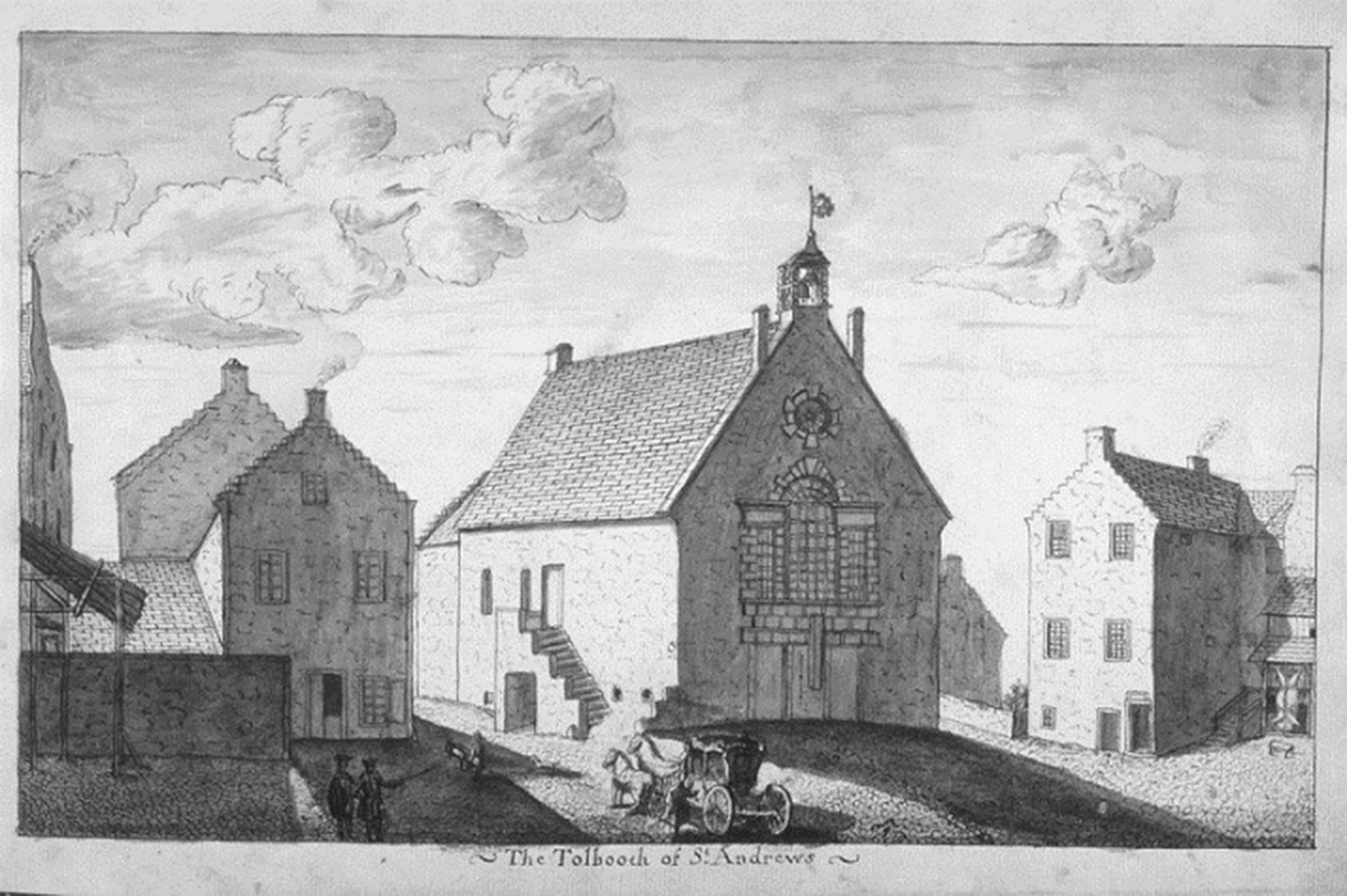
The council minutes record the meetings, correspondence, and decisions of the burgh council of St Andrews, which was held at the tolbooth, which used to stand in the middle of Market Street.
Their contents cover a wide range of material, including copies of royal grants and letters to the town, orders to individual councillors, matters regarding the local church, harbour repairs, town and gown relations, and elections to the council. The main posts on the council were that of the provost, who was head of the council, the dean of guild, who represented the burgh’s tradesmen, the treasurer, and four baillies, the council’s judicial officers. These men were elected every year, typically around Michaelmas (29th September), by the council members. The council’s craftsmen were also represented and accounted for about a third of the council’s membership. As well as the dean of guild, the deacon convener, head of the burgh’s trade guilds, and the deacons of the crafts, masters of each guild, were guaranteed membership. Alongside them were several ordinary council members, who were elected shortly before Michaelmas. Unlike the chief offices, the post of council member appears to have been for life, with new members only elected when the council grew too small. From June 1682, it was mandated that the council should be fixed at twenty men. The size of the council fluctuated from meeting to meeting, with many ordinary members rarely attending except at election time. Despite this, the office of councillor was taken seriously.
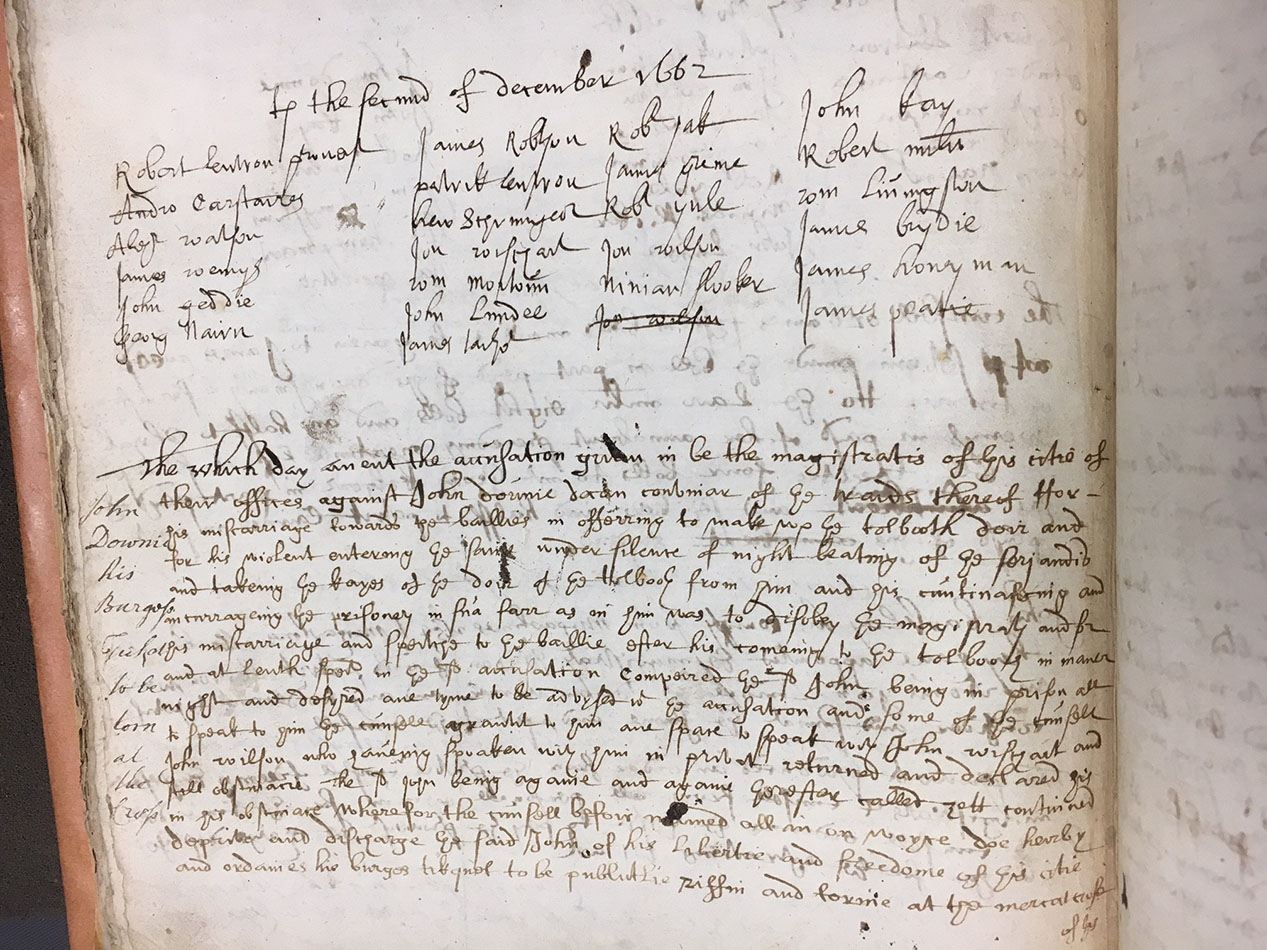
Criminal behaviour could result in being permanently barred from standing for election, as happened to deacon convener John Dounie in 1662 when he attacked the sergeant at the door of the town’s tolbooth and stole his keys (B65/11/1, f. 114).
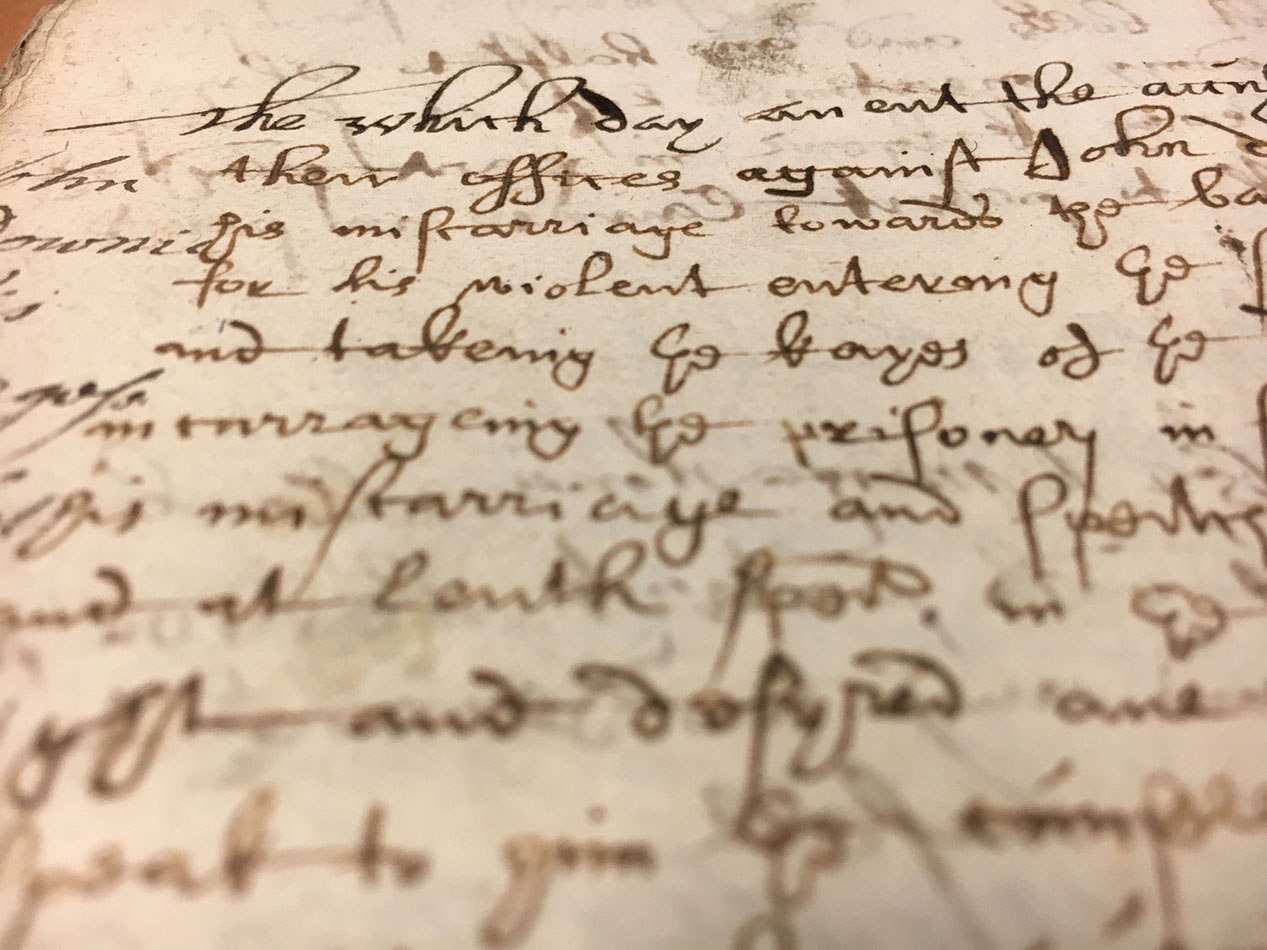
The first volume of council minutes (B65/11/1) covers October 1656 to October 1671. Entries of particular interest include copies of the Humble Petition and Advice and the Additional Petition and Advice of 1657 (f. 19), a 1659 letter to the council from General Monck (ff. 71-2), and a grant by Charles II of funds towards the repair of the town’s bridge, harbour, and pier (f. 105).
The second volume (B65/11/2) contains entries for June 1673 to November 1707. Those for May 1689 to May 1692 are inserted at the end. Entries include several relating to the 1679 murder of James Sharp, archbishop of St Andrews (ff. 68-9), the refusal of many councillors to agree to the 1678 Test Act (ff. 96, 99), the suspension of council elections in 1686 (f. 149), and a letter of advice sent by the council to William and Mary in 1692 (ff. 227-8).

The Councill appoints everie Counsellor To make jntimation
of all reports that comes to ther ears of the horride murder
committit vpone our over lord on Saturday last the third of this
monethe or that any way may contribute to the discoverie therof
Court books
The burgh court of St Andrews was presided over by the town’s provost and four baillies, though often a smaller complement of officials were present at each session, with some led by just one baillie (f. 9v). The cases judged range from trade and inheritances disputes to assault. Unfortunately, the court books often give very little detail about each case. Many cases begin with a claim presented by a petitioner against a defendant. If the claim is judged valid by the presiding officer, then the defendants are summoned. Further entries may note the appearance or non-appearance of defendants, petitioners, and witnesses, any counterclaims made, the appointment of legal representation for each side, and finally a judgement. At each stage, only the bare necessities are recorded. In most cases the petitioner’s complaint is not described, the testimony of witnesses is unrecorded, and the judgements leading to a ruling are unmentioned. Rather than criminal history, the real value of these documents is for genealogical and social history. Many entries make note of family relationships, either because the petition relates to inheritance rights or the son of a burgess was being admitted to the liberty of the city. The long-running disputes and arguments that feature in these records can also indicate the social politics and divisions of the town. Finally, the council minutes and the guildry records reflect just two aspects of the burgh’s population; its leadership and its seven craft guilds. The court records instead feature a much wider spectrum of the inhabitants of early modern St Andrews, including horse-hirers (B65/8/3, f. 43r), bookbinders (f. 49v), brewers (f. 51v), carters (f. 56v), shepherds (f. 14v), apothecaries (f. 52r), and schoolmasters (f. 71v).

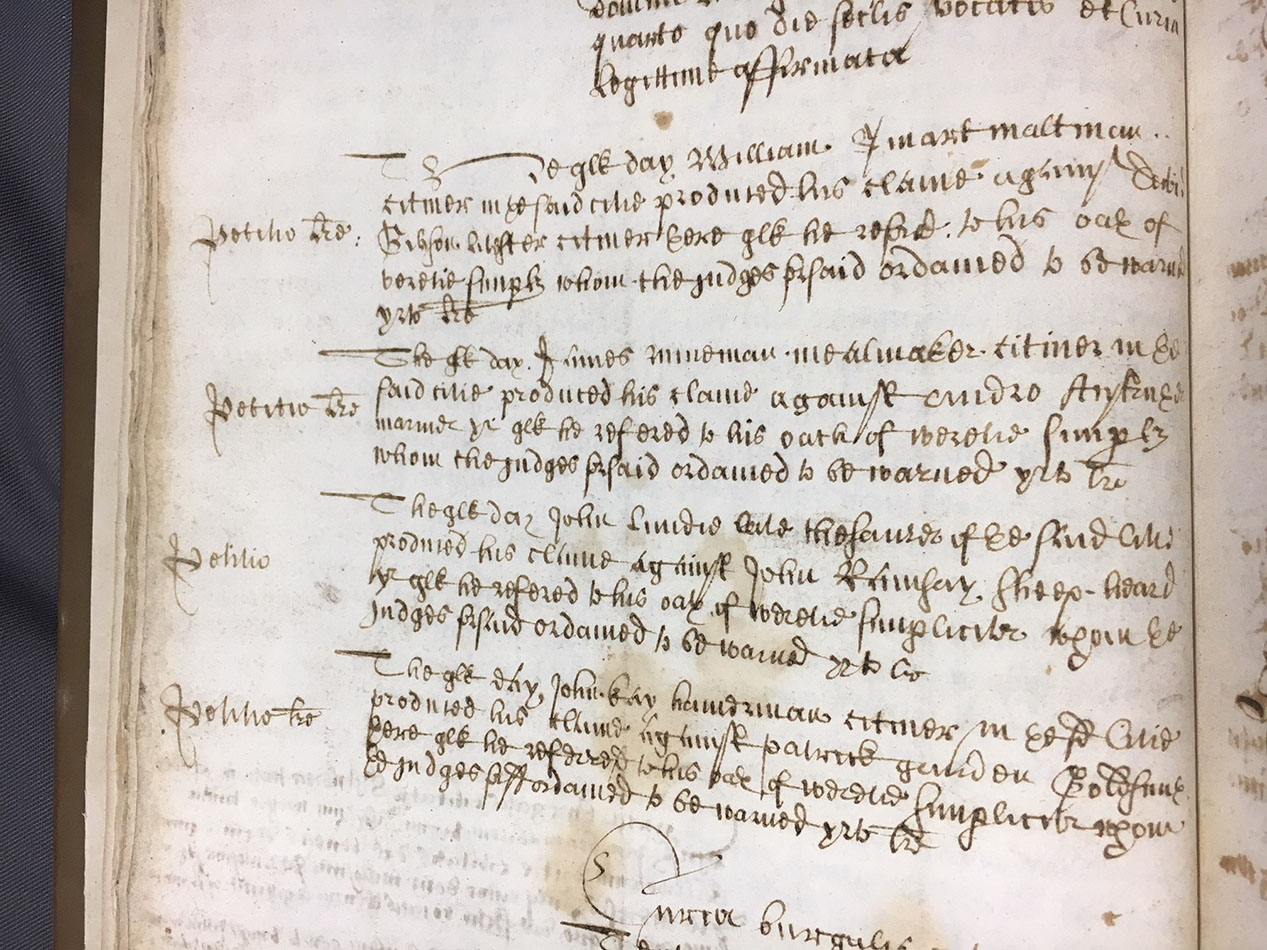
The court book volume used in this index (B65/8/3) is actually two separate volumes that were later bound together. The first of these covers the period March 1664 to December 1665. It appears that part of the text has been lost, as the last entry stops mid-sentence. The second half of this volume contains entries for April 1674 to December 1675. Its entries are generally more detailed than those of the preceding material, with many noting the legal representation in each case and their activities, something almost entirely absent from the first half of the volume. Documents of particular interest across this volume include the appointment of several peers as burgesses in 1664 (f. 5v) and a 1675 case with the archbishop of St Andrews and his factor as claimants (f. 156r).
Book of the Convener of the Seven Trades
Seven craft guilds operated in early modern St Andrews. These organisations regulated their respective trade, provided welfare and support for their members, and represented them politically. The seven trades of St Andrews were the the hammermen (smiths), baxters (bakers), cordiners (shoemakers), fleshers (butchers), tailors, weavers, and wrights. Each guild had an elected head called a deacon. Each year, one of these seven deacons of the crafts was elected as deacon convener, sometimes referred to as the deacon warner, head of the seven guilds. The Convener’s Book contains the proceedings of the court of the deacon convener, which ruled on disputes within and between the guilds. The deacon convener was normally elected on the Saturday after Latter Day (8th September), a Dundee faire. The court often saw little business beyond annual elections, with no other entries surviving from 1634 to 1640. It is possible that the deacon convener originally held a wider remit but later lost jurisdiction to the dean of guild’s guildry court.
The first extant volume of the Convener’s Book (B65/17/1) covers the period April 1594 to February 1817. Entries of particular interest include a copy of the oath taken by the clerk to the court (f. 36r).
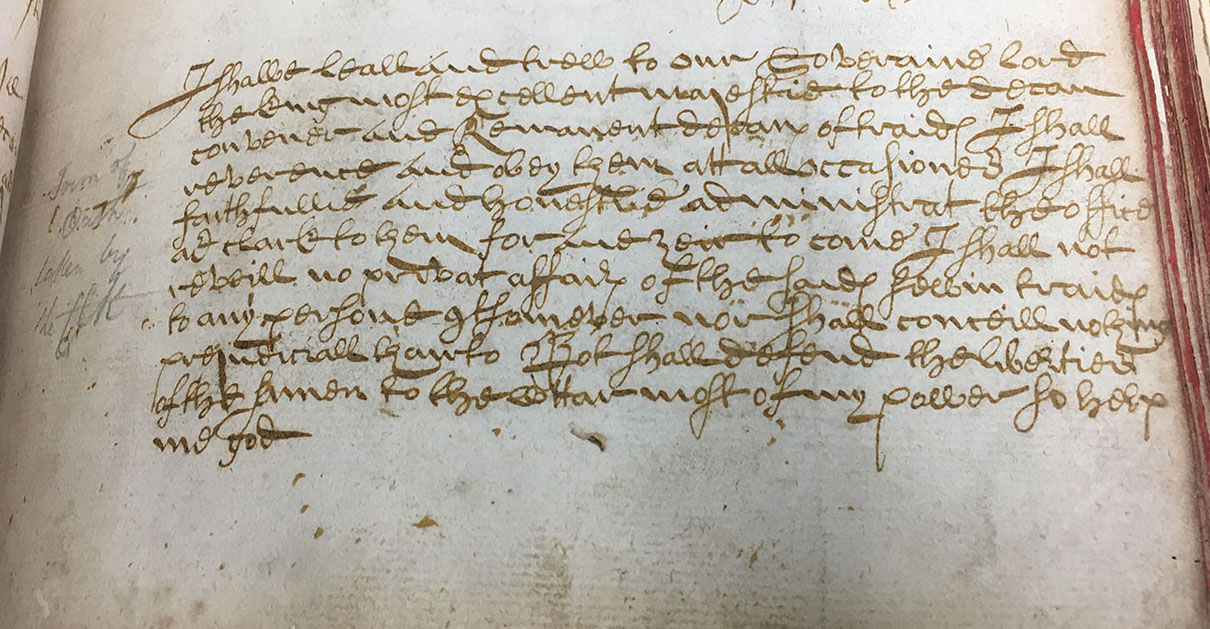
Guildry book
The guildry court appears to have been superior to the convener’s court. It was presided over by the dean of guild and regulated the admission of guildbrethren, provided welfare assistance for guild-members, dealt with conflict between the town and the guilds, and could administer fines for violating commercial regulations. The dean of guild was often very important to the burgh’s administration. He was second only to the provost in terms of status and the council minutes show him taking on many duties unrelated to the guildry.
The first extant volume of the Convener’s Book (B65/16/1) covers the period February 1604 to February 1746. Entries of particular interest include the dean of guild raising funds for mortclothes (f. 68).
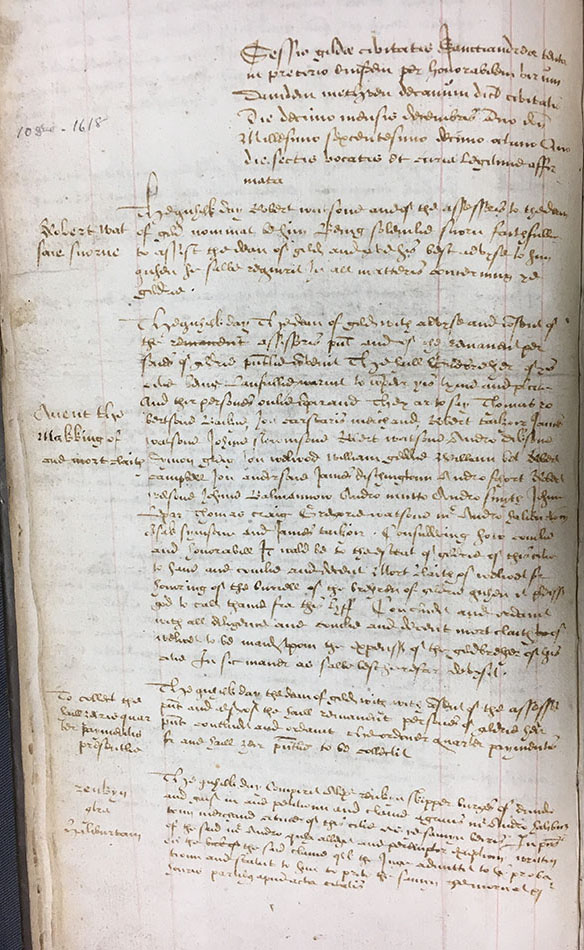
Editorial conventions
This index includes every named person in these records from c. 1550-1700. Each entry includes the manuscript source and page number, the person’s modernised first name, their original and modernised surname, occupation, office or title, and the date and context of their appearance. A notes column includes any other pertinent information given in the record, such as a family relationship.
About the author
Rory MacLellan is a third-year doctoral candidate in medieval history at the University of St Andrews. His main research interests are late medieval Britain and Ireland, the military-religious orders, and the crusades.
The University Library would like to acknowledge the help and support of the National Records of Scotland in making this project possible.
[1] A. M. Carstairs, ‘The Convener’s Court Book of the Seven Incorporated Trades in St. Andrews’, The Scottish Historical Review, Vol. 34, No. 117, Part 1 (Apr., 1955), pp. 32-43.